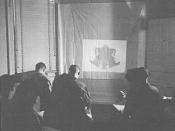Abstract
Staggering interest in leadership coaching comes from the changing trend of our present-day global world. Many large firms are turning their eyes to leadership coaching as a way
to provide the opportunities to their employees to continue to learn and the renew oneself. A case study is introduced to advocate the benefits of leadership coaching especially practiced in a group setting. Leadership group coaching establishes a foundation of trust, provides constructive conflict resolution, leads to greater commitment, and contributes to accountability, all factors that result in better business and improvement of efficiency for the organization. Leadership group coaching creates high-performance teams through building on each other's strengths to become more effective as a team. In order to make the coaching process a success, leadership coaches are required to undergo clinical training to prepare for psychological problems that can be encountered during leadership coaching process. In addition, a clinical approach to organizational intervention is included.
There is also mention about the similarities and differences between leadership coaching and psychotherapy. Adding the threats and issues related to the success or failure of the leadership coaching, I concluded with the shown and potential benefits of the leadership coaching which result in the reason why the organizations need to focus and make investments on such coaching programs.
No matter the size, every organization needs a leader. Needless to mention the importance of the leader's leadership ability, it is essential for organizations to train and nurture each leader of his or her leadership skills. In this aspect, effective training and coaching programs that are usually planned and organized by human resource department have great importance. As a way of clarifying and enhancing consciousness for the leaders, coaching has become the priority for executives and a major activity for many large firms and organizations.
What is the reason for the increasing demand for coaching especially for the executives? The biggest reason for the coaching trend comes from the changes in our present-day global world. As competencies that proved to be highly effective in the past have become outdated, what was an effective way of running a business five years ago is no longer valid today. With these changes, there is relentless pressure on executives to transform their way of thinking to accommodate present-day realities while achieving bottom-line results. New ways are needed to help reinvent and revitalize highly stressed executives and prevent burnout. Thus as a way to provide the opportunity to continue to learn and the renew oneself, coaching has become the most powerful strategic weapon.
It is clearly shown from a case study the necessity and importance of the leadership coaching (Kets de Vries, M.F.R., 2005). It is a case of a company undergoing a transition period with its eight executive board members experiencing a leadership group coaching. Before the coaching took place, there were unspoken conflicts among the executive team and a lack of trust among themselves. This coaching process was planned by their new CEO for the purpose to resolve conflicts and build mutual trust so to form stronger and more effective top executive team. The first step of the coaching was to help executives understand their own competencies and weaknesses. The tool the leadership coach used was 360-degree feedback instrument called 'The Global Executive Leadership Inventory', (Kets de Vries, M.F.R., 2004) an instrument that measures leadership in twelve dimensions, including: visioning, empowering, energizing, designing and aligning, rewarding and feedback, teambuilding, outside orientation, tenacity, global mind-set, and emotional intelligence. The members themselves and seven to ten work colleagues called "observers" were asked same questions about the target participant. In addition, observers were to comment on the behavior the target participant should continue, develop or eliminate which made the feedback session more relevant for each participant. All the responses were summarized in a report, a graph that compared results of self-reporting with the aggregated results of their observers' questionnaires. In addition, each board members and their good friends or family members were asked to complete 'The Personality Audit' (Kets de Vries, M.F.R., 2003) that measures personality dimensions such as sense of self-esteem, conscientiousness, trust, assertiveness, extroversion, mood state, and adventurousness. This feedback was to help the executives understand how they managed their public and private selves, and illustrate the level of consistency of their presentation of self. Finally, the executives were asked to complete a short biographical sketch to help leadership coach better understand the general background of each person.
The main precondition for an effective intervention is a relationship of mutual trust and respect between coach and client, so called the working alliance by clinical psychologists. An important task for the coach in this session is to help the executives relax so they could reflect honestly on their observers' comments. Lack of trust and respect between the two may result in defensive reaction from the client.
While sharing with the group feedback each participant received, other group members gave their reactions to that feedback. Between discussions, the leadership coach added some of the written comments received from observers. Also, the leadership coach made sure that each participant's strengths were emphasized and weaknesses reframed in a positive way to reduce defensive reactions since this kind of reframing was a very effective way to reinforce self-esteem and make the participant more willing to make an effort to change. During the review, the participants were asked to mention few things about their background as a way to help the others understand his or her way of looking at the world which could give others a different view of a person who had been their colleague for many years. There was also a session that allowed others to talk and participant listen. Others commented freely about the participant including advices to help the participant to become even more effective. During this process the leadership coach actively listened and tried to comprehend the key issues, using humor from time to time as a highly effective means of clarifying certain points and defusing tension.
As a result of the group dynamics of discussions, the group members became to recognize how they could complement each other, how they could build on each other's strengths to become more effective as a team.
Each session was ended with a discussion of how to design their own personal development plans. Development plans included what he or she had learned, which one or two areas each of them planned to work on, how they are going to deal with the people who provided the feedback. They were asked to write a realistic, measurable action plan with a timeline. It is important to have an internal leadership coach to monitor progress who could help them monitor and assist them to implement the desired changes. Lastly, a follow-up meeting was to be held to discuss that has been done and how well they met their set objectives that would be essential for successful change (Kets de Vries, M.F.R., 2005).
The major benefits from the leadership group coaching exercise could be summarized as follows. The executives became more of a high EQ team (Gardner, H., 1999). The members became more aware of the interpersonal role in which they consciously or unconsciously had cast themselves (Kets de Vries, M.F.R., 2000). The members also learned what it meant to coach others and to be better listeners. Listening to the others forms solid relationships based on better understanding between the team members which could mean better business. In addition, the executive board members started to feel that they had become much more of a team. Sharing common goals and values, they built higher level of trust and mutual respect among themselves. Strong teamwork means synergy effect which also means better business. Conflicts between the executive team became rare, meaning more open communications within the team. Learning their ineffective behavior patterns, each executive willingly tried to unlearn the specific behavior patterns. In line with the changes the board member experienced, it is important for the CEO to review the group coaching results and rearrange the roles and tasks in case he feels the changes are necessary.
In conclusion, under the premise that the coaching has been made on the mutual trust and respect between the coach and the participants, the group leadership coaching exercise allows the team to reflect on each other's leadership style, learn from other's strengths and point out each other's weakness so that each member could gain true leadership. At the end, this will result in improving financial results of the company.
Compared to the coaching done in groups, private coaching sessions rarely have a lasting impact as they are too infrequent. All too often, when the coached individual is back in his or her working environment, "automatic pilot" takes over and wipes out lessons taught (Kets de Vries, M.F.R., 2005).
In order to make people change, external pressure is needed. That is to say, by making announcement out-loud, the person involves others giving them a stake in the process. The others that hear the announcement changes into "rubber fence" (Kets de Vries, M.F.R., 2005) that supports and helps the participants to change. In the case, the members of the group set boundaries that become important force in behavior change helping the person to live up to his or her promises.
Also, the powerful emotional experiences that come out of group leadership coaching are change facilitators. By telling their stories and revealing something about themselves, they undergo a journey of self-understanding. Through storytelling, people could rediscover themselves and could also give valuable lessons to the listeners as well.
The importance of trust has already been mentioned many times. Trust depend on the willingness to look not only to own interests, but also to the interests of others. For trust to exist, we need to deal with such complicated issues as openness, honesty, active listening, communication, consistency, competence, fairness, and mutual respect (Solomon, R.C., & Flores, F., 2003). As shown from the case, when leadership coaching takes place in groups, people get to know each other better, understand each other's leadership styles, become to know each other's competences and finally become to trust each other. Through this transition, people slowly open up and begin to share information and their common values. They stop fighting and start to support each other. If there is absence of trust, knowledge management cannot take place. Since knowledge means power, trust between each other is the foundation to make people share their knowledge. Thus only when there is solid degree of trust can there be true knowledge management (Morey, D. (Ed.). 2002). At the end, true knowledge management means creating teams and organizations in with the participants trust each other and realize the benefits of knowledge sharing for everybody involved.
Effective and constructive leadership coaching is built on a solid base of psychological understanding and practice while most traditional intervention techniques focus on rational side of human behavior neglecting the non-rational side of human behavior that are part and parcel of the human condition (Hirschhorn, L., 1998). Therefore, the leadership coach's understanding in psychological techniques and methods becomes essential part deciding the coaching to be successful or not. If the coach does not maintain the background in dynamic psychotherapy, the psychological problem would be neglected and ignored, driving the whole leadership coaching process into failure. This could cause the individual and the organization great harm.
As mentioned, both leadership coaching and psychotherapy have many things in common; both deal with behavior, emotion, and cognition. It depends on how deep the leadership coach and the client are willing to go but leadership coaching can look very much like short-term psychotherapy. In terms of the differences between the two, leadership coaches have broader perspective than psychotherapists, since leadership coaches are required to know not only the essentials of psychotherapy but also the requirements of organizational management (Levinson, H., 2002). In addition, while psychotherapy is more past, present, and future oriented, coaching has a more present and future oriented (Rawson, P., 2002). In other words, psychotherapy is more passive and reflective focusing on symptom reduction while leadership coaching is more active goal-and-action oriented focusing on personal growth and skill development. Also, there is difference in confidentiality; in psychotherapy, confidentiality is absolute while in leadership coaching confidentiality is not as clear.
Regardless of many benefits that come from leadership coaching, there still lie some threats and issues regarding the success of the leadership coaching; whether the coaching process could turn out to be success or failure. First, there is issue regarding leadership coach's skill. In order to make the coaching process a success, the coach has to possess solid base of psychological understanding and practice. There could be an issue of confidentiality and ethical issue such as the question of participant's consent. Also, there could be a question of money as well. Despite mentioned threats and issues, it is clear that the benefits derived from successful leadership coaching usually exceed our expectations. One of the most important benefits could be synergy effect the coaching may have throughout the organization. Since this coaching process deals directly with group of executives or any equivalent level group, the good effects are likely to affect their subordinates making the changes and improvements beyond limitation.
Once again, the most powerful resource in the organization is human, especially the leaders among them. Therefore, the efforts such as making investments on leadership coaching programs that make the leaders a great leader and furthermore lead the team to success should not be neglected by the organizations.
References
Kets de Vries, M.F.R. (2005) Leadership group coaching in action: The Zen of creating high performance teams.
Kets de Vries, M.F.R. (2004) The global executive leadership inventory: Facilitator's guide. San Francisco: Pfeiffer.
Kets de Vries, M.F.R. (2003) The personality audit. INSEAD, Fontainebleau, France.
Gardner, H. (1999) Intelligence reframed. New York: Basic Books.
Kets de Vries, M.F.R. (2000) Struggling with the demon: Perspectives in individual and organizational irrationality. Madison, CN: Psychosocial Press.
Solomon, R.C., & Flores, F. (2003) Building trusts: In business, politics, relationships, and life. New York: Oxford University Press.
Morey, D. (Ed.). (2002) Knowledge management: Classic and contemporary works. Cambridge, MA: MIT Press.
Hirschhorn, L. (1998) The workplace within: Psychodynamics of organizational life. Boston: MIT Press.
Levinson, H. (2002) Organizational assessment. Washington, DC.
Rawson, P. (2002) Short-term psychodynamic psychotherapy: An analysis of the key principals. London.
Robert L. Mathis & John H. Jackson (2003) Human resource management: Tenth edition.


